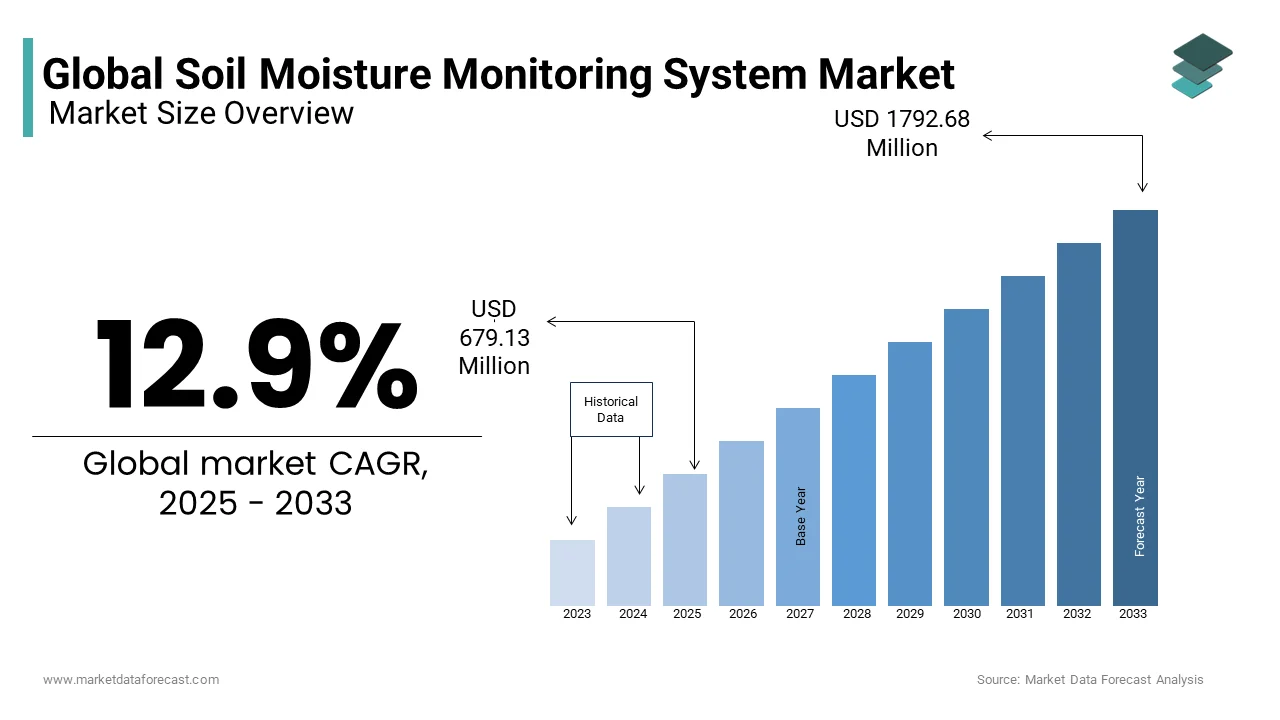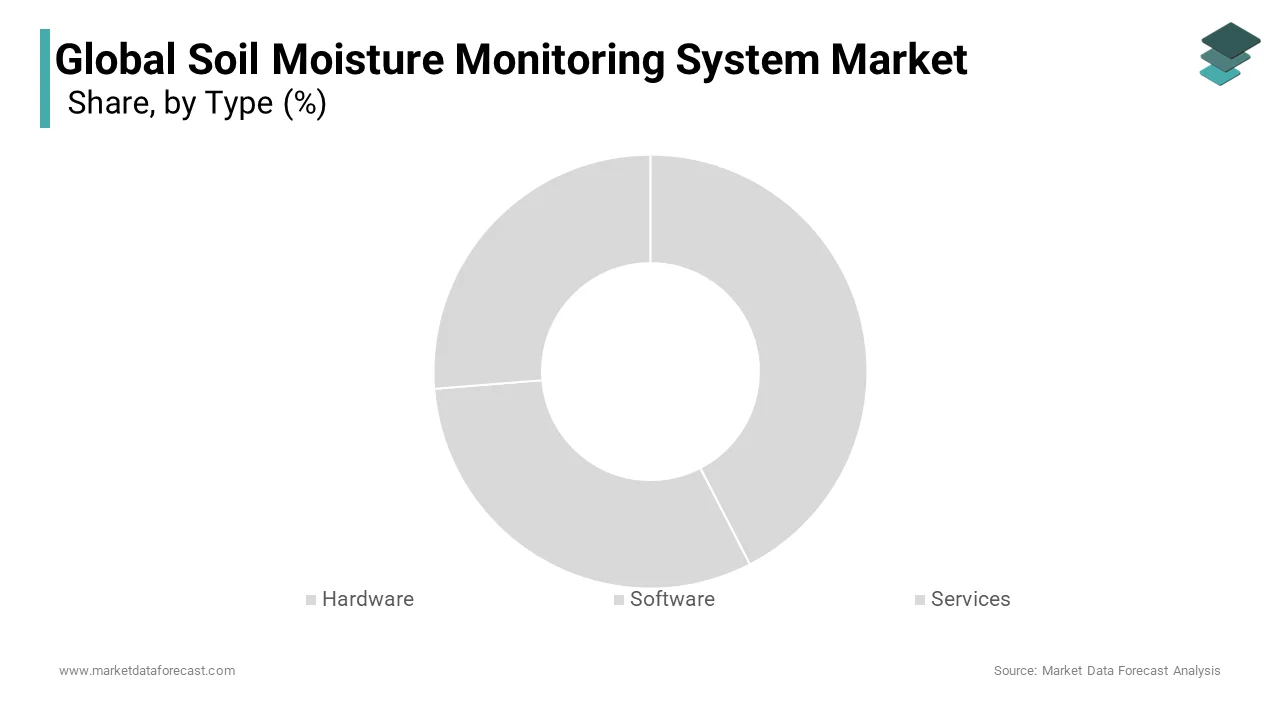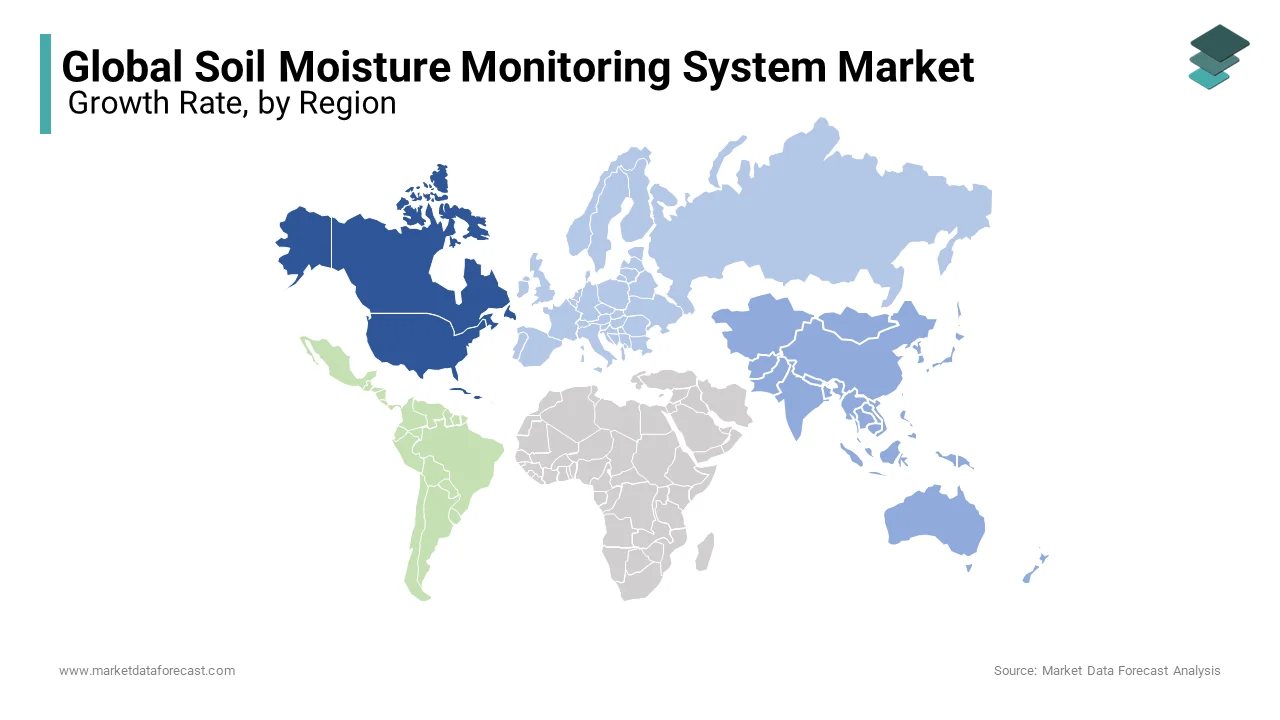Global Soil Moisture Monitoring System Market Size, Share, Trends & Growth Forecast Report, Segmented By Offering (Hardware, Software, Services), System Type (Sensing & Imagery, Ground-based Sensing, Robotics Telematics), Application (Agriculture, Non- Agriculture) And By Region (North America, Europe, Latin America, Asia-Pacific, Middle East and Africa), Industry Analysis From 2025 to 2033
Global Soil Moisture Monitoring System Market Size
The global soil moisture monitoring system market was valued at USD 601.53 million in 2024 and is anticipated to reach USD 679.13 million in 2025, from USD 1792.68 million by 2033, growing at a CAGR of 12.9% during the forecast period from 2025 to 2033.

A soil monitoring system is a system that is used to measure or monitor volumetric water content in soil. Combining effective irrigation management strategies with more efficient irrigation systems and soil monitoring systems helps producers use water more efficiently and reduce the energy used in irrigation. Excessive irrigation not only increases the cost of production from additional pumping and electricity used, but also causes excessive fertilizer torun offf anleachng without an economic increase in production. On the other hand, providing insufficient water for the crops limits transpiration and photosynthesis and, in turn, hinders crop growth and reduces yields and crop quality.
The soil monitoring system includes hardware and software for measuring the water content in soil. The various types of soil moisture monitoring systems present in the market include Sensing & Imagery, Ground-based Sensing, Robotics, and Telematics. The soil monitoring system is used in both agricultural and non-agricultural applications. In Agricultural soil, moisture monitoring systems play a vital role in optimal quality crop production and also help in reducing extra costs like water bills for irrigation, labor costs, urea and other fertilizer costs, etc. Due to increasing technological advancements, governments of several countries around the globe are investing in the digitization of agriculture.
Moreover, governments are providing subsidies to farmers to adopt different systems to maximize the quality of crops. Thus, technological advancement and governmental support drive the growth of global soil moisture monitoring systems in the period between 2022 and 2027.
MARKET DRIVERS
The driving force of the soil moisture monitoring system market is the surging need for advanced techniques for measuring soil moisture to get good crops. In countries like the U.S., Canada, the Netherlands, Israel, Denmark, and Australia, progressive farmers have shown their interest in soil monitoring to improve soil quality and crop yield. Thus, farmers in several countries are adopting soil monitoring systems to maintain soil quality and get maximum yields. The soil moisture monitoring system prevents over-irrigation of fields by measuring soil moisture content. If the soil gets overwatered, the nutrients present in the soil get washed off, which affects the quality of the crop. Due to increasing crop quality and production, the demand for soil monitoring systems is increasing, which fuels the growth of the market.
The rising focus of key players on developing advanced soil moisture monitoring systems to monitor the soil moisture for agricultural and non-agricultural requirements. The increasing awareness and adoption of automated soil monitoring systems help in getting good quality and maximum yields, and also reduce labor costs and minimize the damage to soil quality. These automated soil monitoring systems proved to be a blessing in this COVID situation. Owing to these factors, the demand for automated soil monitoring devices will increase, which will drive the growth of the market in the projected period. Additionally, the government is providing support for digitizing agriculture, increasing the demand for digital devices for soil moisture monitoring, which drives the growth of the market.
The rising government and companies promoting sustainable agricultural practices propel the growth of the market. Furthermore, the surging call to preserve soil quality, stringent government regulations about ecological stability, and the growing need for improving farm productivity to feed the rising population are some of the key factors that propel the growth of the global soil moisture monitoring system market.
MARKET RESTRAINTS
The soil spatial variability is a key factor hindering the development of the soil monitoring market due to the spatial variability of soil; it is not viable to monitor every single parameter to represent wide areas, primarily grounds, and farms.
Impact of COVID-19 on Global Soil Moisture Monitoring System Market
The global soil moisture monitoring system market has been significantly impacted by the COVID-19 outbreak. Due to COVID-19, global factories have struggled to assimilate new soil moisture monitoring systems because workers have stayed at their homes, which disrupted the global supply chains and affected the global market. Strict lockdowns and preventions like social distancing have been imposed, which resulted in a labor crisis that has affected the agriculture sector as well as the crops. However, due to COVID-19, technologically advanced soil monitoring devices like robotics and telematics overcome challenges like labor, as well as get more accurate results by adopting automated soil monitoring devices likely to be less affected by diseases like COVID. Therefore, the demand for advanced soil moisture monitoring devices will increase, which will drive the growth of the market in the forecast period.
REPORT COVERAGE
|
REPORT METRIC |
DETAILS |
|
Market Size Available |
2024 to 2033 |
|
Base Year |
2024 |
|
Forecast Period |
2025 to 2033 |
|
CAGR |
12.9% |
|
Segments Covered |
By Offering, System, Application, and Region |
|
Various Analyses Covered |
Global, Regional & Country Level Analysis, Segment-Level Analysis, DROC, PESTLE Analysis, Porter’s Five Forces Analysis, Competitive Landscape, Analyst Overview on Investment Opportunities |
|
Regions Covered |
North America, Europe, APAC, Latin America, Middle East & Africa |
|
Market Leaders Profiled |
Stevens Water Monitoring Systems (US), SGS Group (Switzerland), METER Group (US), Element Material Technology (UK), The Toro Company (US), Campbell Scientific (US), Sentek Technologies (Australia), Spectrum Technologies (US), Irrometer (US), CropX Technologies (Israel).
|
SEGMENTAL ANALYSIS
By Offering Insights
The hardware segment is going to boost market growth during the forecast period due to the increasing penetration of soil monitoring devices such as soil sensors, soil scanners, weather stations, and other devices for soil monitoring. These devices need the best quality hardware that can withstand different environmental conditions; thus, the demand for quality hardware for monitoring systems is increasing, which in turn drives the growth of the market.

By System Insights
Ground-based monitoring systems are dominating the market during the forecast period due to the increasing adoption of sensors and other monitoring devices that have been in demand by progressive farmers around the globe. Thus, this device has several benefits that enable the growers to provide site-specific input to crops. Telematics and robotics are expected to dominate the market because farmers are facing major challenges like labor crises and associated costs. To overcome this challenge, the demand for automated monitoring systems such as robotics and telematics is increasing, which will further drive the growth of the soil moisture monitoring system market shortly.
By Application Insights
The soil moisture monitoring system plays a vital role in agricultural applications. The soil moisture monitoring systems help in providing good irrigation management. Through good irrigation management, irrigators can get good crops, use fewer inputs, and increase profitability. Soil moisture sensors help irrigators understand what is happening in the root zone of a crop. Thus, the agriculture segment drives the demand for soil moisture monitoring systems in the market during the forecast period between 2022 and 2027.
REGIONAL ANALYSIS
Americas (North America and South America) are the largest contributors to the growth of soil moisture monitoring systems due to increasing awareness and adoption of soil monitoring technology for enhancing the production and quality of crops. Several countries in this region are investing more in technology and advanced agriculture. The shortage of labor in this region has led farmers to adopt remote sensing imagery devices, which will further boost the demand for advanced technology-based soil moisture monitoring systems. Thus, the increasing adoption of automated devices boosts the growth of the soil moisture monitoring system market in the forecast period.

Asia-Pacific is expected to witness fast growth during the forecast period between 2022 and 2027. The huge adoption of ground-based and sensing imagery systems for soil monitoring for proper plant formation and high crop yields is one of the major factors that drive the growth of soil monitoring systems in the market. In the Asia-Pacific region, countries like India, China, Japan, and Australia have promising growth prospects in the soil moisture monitoring market due to the presence of various international and domestic players in the soil monitoring field. Additionally, in the APAC region, the governing bodies of several countries are providing strong support for digitizing agriculture to improve the quality and productivity of crops. Thus, government support and investment in increasing crop quality and productivity by using advanced technology propels the growth of the soil moisture monitoring market in the forecast period.
KEY MARKET PLAYERS
Some of the leading companies operating in the global soil moisture monitoring system market are, Stevens Water Monitoring Systems (US), SGS Group (Switzerland), METER Group (US), Element Material Technology (UK), The Toro Company (US), Campbell Scientific (US), Sentek Technologies (Australia), Spectrum Technologies (US), Irrometer (US), CropX Technologies (Israel).
RECENT HAPPENINGS IN THE MARKET
- In 2021, the researcher in University of Australia and Baghdad’s Middle Technical University developed a cost-effective new technique to monitor soil moisture using a standard digital camera and machine learning technology that may make precision soil monitoring simple and affordable in almost any circumstance.
- In 2021, Sensoterra launched a new web monitoring “Sensoterra Web monitor” for their soil moisture sensor with new features, i.e., data sharing through team members, adding custom properties to the sensor, and seeing multiple-depth soil moisture sensor graphs.
MARKET SEGMENTATION
This research report on the global soil moisture monitoring market is segmented and sub-segmented into the following categories.
By Offering
- Hardware
- Software
- Services
By System
- Sensing & Imagery
- Ground-based Sensing
- Robotics
- Telematics
By Application
- Agriculture
- Non- Agriculture
By Region
- North America
- Europe
- Asia Pacific
- Latin America
- Middle East & Africa
Frequently Asked Questions
What is a soil moisture monitoring system, and why is it important for agriculture?
A soil moisture monitoring system measures the water content in the soil, helping farmers optimize irrigation, improve crop yields, conserve water resources, and make smarter land management decisions.
What factors are driving the growth of the global soil moisture monitoring market?
Major drivers include the global focus on precision agriculture, rising concerns about water scarcity, increasing demand for higher agricultural productivity, and government incentives promoting smart farming technologies.
What types of technologies are commonly used in soil moisture monitoring systems?
Key technologies include tensiometers, capacitance sensors, time-domain reflectometry (TDR), and advanced wireless IoT-based systems that provide real-time soil data through cloud platforms.
What challenges are limiting wider adoption of soil moisture monitoring systems?
Barriers include high upfront investment costs, limited technical knowledge among small farmers, variability of performance across different soil types, and lack of standardized data integration platforms.
What future trends are shaping the soil moisture monitoring system market?
Emerging trends include AI-powered soil analytics, drone-integrated moisture sensing, low-cost smart sensors for small-scale farms, and the increasing integration of soil data with full-farm automation platforms.
Related Reports
Access the study in MULTIPLE FORMATS
Purchase options starting from $ 2500
Didn’t find what you’re looking for?
TALK TO OUR ANALYST TEAM
Need something within your budget?
NO WORRIES! WE GOT YOU COVERED!
Call us on: +1 888 702 9696 (U.S Toll Free)
Write to us: [email protected]